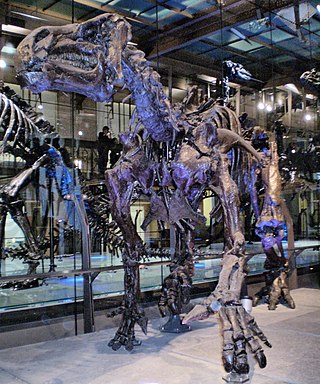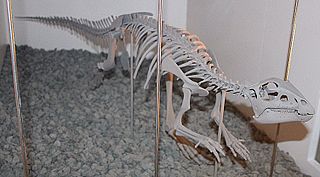
Iguanodon, named in 1825, is a genus of iguanodontian dinosaur. While many species found worldwide have been classified in the genus Iguanodon, dating from the Late Jurassic to Early Cretaceous, taxonomic revision in the early 21st century has defined Iguanodon to be based on one well-substantiated species: I. bernissartensis, which lived during the Barremian to early Aptian ages of the Early Cretaceous in Belgium, Germany, England, and Spain, between about 126 and 122 million years ago. Iguanodon was a large, bulky herbivore, measuring up to 9–11 metres (30–36 ft) in length and 4.5 metric tons in body mass. Distinctive features include large thumb spikes, which were possibly used for defense against predators, combined with long prehensile fifth fingers able to forage for food.

Qantassaurus is a genus of basal two-legged, plant-eating elasmarian ornithischian dinosaur that lived in Australia about 125-112 million years ago, when the continent was still partly south of the Antarctic Circle. It was described by Patricia Vickers-Rich and her husband Tom Rich in 1999 after a find near Inverloch, and named after Qantas, the Australian airline.

Ouranosaurus is a genus of herbivorous basal hadrosauriform dinosaur that lived during the Aptian stage of the Early Cretaceous of modern-day Niger and Cameroon. Ouranosaurus measured about 7–8.3 metres (23–27 ft) long and weighed 2.2 metric tons. Two rather complete fossils were found in the Elrhaz Formation, Gadoufaoua deposits, Agadez, Niger, in 1965 and 1970, with a third indeterminate specimen known from the Koum Formation of Cameroon. The animal was named in 1976 by French paleontologist Philippe Taquet; the type species being Ouranosaurus nigeriensis. The generic name is a combination of ourane, a word with multiple meanings, and sauros, the Greek word for lizard. The specific epithet nigeriensis alludes to Niger, its country of discovery. And so, Ouranosaurus nigeriensis could be interpreted as "brave lizard originating from Niger".

Camptosaurus is a genus of plant-eating, beaked ornithischian dinosaurs of the Late Jurassic period of western North America and possibly also Europe. The name means 'flexible lizard'.

Hypsilophodontidae is a traditionally used family of ornithopod dinosaurs, generally considered invalid today. It historically included many small bodied bipedal neornithischian taxa from around the world, and spanning from the Middle Jurassic until the Late Cretaceous. This inclusive status was supported by some phylogenetic analyses from the 1990s and mid 2000s, although there have also been many finding that the family is an unnatural grouping which should only include the type genus, Hypsilophodon, with the other genera being within clades like Thescelosauridae and Elasmaria. A 2014 analysis by Norman recovered a grouping of Hypsilophodon, Rhabdodontidae and Tenontosaurus, which he referred to as Hypsilophodontia. All other analyses from around the same time have instead found these latter taxa to be within Iguanodontia.

Minmi is a genus of small herbivorous ankylosaurian dinosaur that lived during the early Cretaceous Period of Australia, about 120 to 112 million years ago.

The Iguanodontia are a clade of herbivorous dinosaurs that lived from the Middle Jurassic to Late Cretaceous. Some members include Camptosaurus, Dryosaurus, Iguanodon, Tenontosaurus, and the hadrosaurids or "duck-billed dinosaurs". Iguanodontians were one of the first groups of dinosaurs to be found. They are among the best known of the dinosaurs, and were among the most diverse and widespread herbivorous dinosaur groups of the Cretaceous period.

Altirhinus is a genus of hadrosauroid ornithopod dinosaur from the Early Cretaceous period of Mongolia.

Iguanodontidae is a family of iguanodontians belonging to Styracosterna, a derived clade within Ankylopollexia.

Cumnoria is a genus of herbivorous iguanodontian dinosaur. It was a basal iguanodontian that lived during the Late Jurassic period in what is now Oxfordshire, United Kingdom.

Talenkauen is a genus of basal iguanodont dinosaur from the Campanian or Maastrichtian age of the Late Cretaceous Cerro Fortaleza Formation, formerly known as the Pari Aike Formation of Patagonian Lake Viedma, in the Austral Basin of Santa Cruz, Argentina. It is based on MPM-10001A, a partial articulated skeleton missing the rear part of the skull, the tail, and the hands. The type and only species is Talenkauen santacrucensis.

Probactrosaurus is an early herbivorous hadrosauroid iguanodont dinosaur. It lived in China during the Early Cretaceous period.

Gasparinisaura is a genus of herbivorous ornithopod dinosaur from the Late Cretaceous.
Ralph E. Molnar is a paleontologist who had been Curator of Mammals at the Queensland Museum and more recently associated with the Museum of Northern Arizona. He is also a research associate at the Texas natural Science Centre. He co-authored descriptions of the dinosaurs Muttaburrasaurus, Kakuru, Minmi and Ozraptor, as well as the mammal Steropodon.

Mantellisaurus is a genus of iguanodontian dinosaur that lived in the Barremian and early Aptian ages of the Early Cretaceous Period of Europe. Its remains are known from Belgium (Bernissart), England, Spain and Germany. The type and only species is M. atherfieldensis. Formerly known as Iguanodon atherfieldensis, the new genus Mantellisaurus was erected for the species by Gregory Paul in 2007. According to Paul, Mantellisaurus was more lightly built than Iguanodon and more closely related to Ouranosaurus, making Iguanodon in its traditional sense paraphyletic. It is known from many complete and almost complete skeletons. The genus name honours Gideon Mantell, the discoverer of Iguanodon.

Dryosauridae was a family of primitive iguanodonts, first proposed by Milner & Norman in 1984. They are known from Middle Jurassic to Early Cretaceous rocks of Africa, Europe, and North America.

Dakotadon is a genus of iguanodont dinosaur from the Barremian-age Lower Cretaceous Lakota Formation of South Dakota, USA, known from a partial skull. It was first described in 1989 as Iguanodon lakotaensis, by David B. Weishampel and Philip R. Bjork. Its assignment has been controversial. Some researchers suggest that "I." lakotaensis was more basal than I. bernissartensis, and related to Theiophytalia, but David Norman has suggested that it was a synonym of I. bernissartensis. Gregory S. Paul, working on a revision of iguanodont species, gave "I." lakotaensis its own genus (Dakotadon) in 2008. He measured its length at 6 metres (20 ft) and body mass at 1 metric ton.

Hippodraco is a genus of iguanodontian ornithopod dinosaur from the Early Cretaceous Cedar Mountain Formation of Utah, United States. The genus contains a single species, H. scutodens, known from a partial skeleton belonging to an immature individual.

Iguanacolossus is a genus of iguanodontian ornithopod dinosaur that lived in North America during the Early Cretaceous period. It is known from UMNH VP 20205, the associated holotype with a large partial skeleton of a single individual.

Rhabdodontomorpha is a clade of basal iguanodont dinosaurs. This group was named in 2016 in the context of the description, based on Spanish findings of an early member of the Rhabdodontidae. A cladistic analysis was conducted in which it was found that Muttaburrasaurus was the sister species of the Rhabdodontidae sensu Weishampel. Therefore, Paul-Emile Dieudonné, Thierry Tortosa, Fidel Torcida Fernández-Baldor, José Ignacio Canudo and Ignacio Díaz-Martínez defined Rhabdodontomorpha as a nodal clade: the group consisting of the last common ancestor of Rhabdodon priscus Matheron, 1869 and Muttaburrasaurus langdoni Bartholomai and Molnar, 1981; and all its descendants. Within the clade Zalmoxes and Mochlodon are also included. The clade is characterized by the following synapomorphies:































